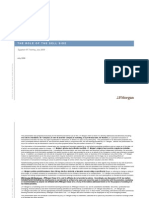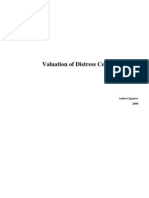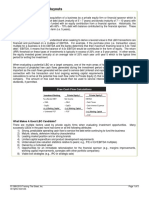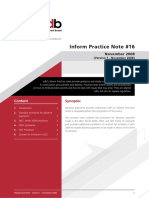Defining Free Cash Flow Top-Down Approach
Defining Free Cash Flow Top-Down Approach
Uploaded by
chuff6675Copyright:
Available Formats
Defining Free Cash Flow Top-Down Approach
Defining Free Cash Flow Top-Down Approach
Uploaded by
chuff6675Original Description:
Original Title
Copyright
Available Formats
Share this document
Did you find this document useful?
Is this content inappropriate?
Copyright:
Available Formats
Defining Free Cash Flow Top-Down Approach
Defining Free Cash Flow Top-Down Approach
Uploaded by
chuff6675Copyright:
Available Formats
Discounted Cash Flow Methodology
Defining Free Cash Flow
Earnings before interest and taxes (EBIT) Subtract adjusted taxes
Top-Down Approach
Consolidated operating income related to the subject operations. Calculated by multiplying the marginal tax rate by EBIT after adding back items which are not tax deductible such as non-deductible goodwill amortization. Subtract (add) estimated increases in net deferred tax liabilities (assets) from taxes calculated directly above. If the company has NOLs or is not expected to be a taxpayer within the forecast horizon, there should be no cash tax expense.
Add depreciation and amortization Subtract (add) increases (decrease) in working capital
Includes all depreciation and amortization subtracted from EBITDA to arrive at EBIT. Includes changes in accounts receivable, inventory, prepaid expenses, accounts payable, accrued liabilities, etc. In some cases, it may be appropriate to include as working capital the minimum amount of cash necessary for operational purposes.
Subtract capital expenditures Equals free cash flows to the unlevered firm (FCFF) Subtract cash interest paid Add interest tax shield Add (subtract) increases (decreases) in debt, preferred stock and minority interest Subtract preferred dividends
Going forward, should include one-time, non-recurring cash flows to the extent they are planned. Cash flows are available to both debt and equity holders. May differ from interest expense due to non-cash interest charges. Calculated by multiplying marginal tax rate by interest expense. Increases in non-common equity sources of capital, net of principal repayments, result in greater cash for common equity holders. Any cash payments to non-common equity claimholders results in less cash to common equity holders. Cash flows are available only to common equity holders. Assumes that all cash flows to the common equity are distributed (i.e., not reinvested) to ensure that retained earnings are not double-counted.
Equals free cash flows to the common equity (FCFCE)
CONFIDENTIAL
Draft of DCF Primer 5467729.doc, printed 1/25/2005 6:20 PM
Discounted Cash Flow Methodology
Defining Free Cash Flow
Net income Add (subtract) non-cash expenses (income) Subtract (add) increases (decreases) in working capital
Bottom-Up Approach
Net income as reported. Includes depreciation and amortization, deferred taxes, and other non-cash items but excludes non-cash interest expense. Includes changes in accounts receivable, inventory, prepaid expenses, accounts payable, accrued liabilities, etc. In some cases, it may be appropriate to include as working capital the minimum amount of cash necessary for operational purposes.
Equals adjusted cash flows from operations Add interest expense Includes non-cash interest expense. As long as you assume that initial excess cash and all interim cash flows are distributed to shareholders (i.e., no cash other than minimum cash balances accumulates in the forecast period), it is appropriate to exclude interest income on excess cash balances from the free cash flow calculation. Calculated by multiplying the marginal tax rate by interest expense. If the company has NOLs or is not expected to be a taxpayer within the forecast horizon, there should be no interest tax shield. Going forward, should include one-time, non-recurring cash flows to the extent they are planned. Cash flows are available to both debt and equity holders. May differ from interest expense due to non-cash interest charges. Calculated by multiplying marginal tax rate by interest expense. Increases in non-common equity sources of capital, net of principal repayments, result in greater cash for common equity holders. Any cash payments to non-common equity claimholders results in less cash to common equity holders. Cash flows are available only to common equity holders. Assumes that all cash flows to the common equity are distributed (i.e., not reinvested) to ensure that retained earnings are not double-counted. 6
Subtract interest tax shield Subtract capital expenditures Equals free cash flows to the unlevered firm (FCFF) Subtract cash interest paid Add interest tax shield Add (subtract) increases (decreases) in debt, preferred stock and minority interest Subtract preferred dividends
Equals free cash flows to the common equity (FCFCE)
CONFIDENTIAL
Draft of DCF Primer 5467729.doc, printed 1/25/2005 6:20 PM
You might also like
- Ecm & DCMDocument114 pagesEcm & DCMYuqingNo ratings yet
- Netflix Equity Debt Convertible Investment Banking Pitch BookDocument15 pagesNetflix Equity Debt Convertible Investment Banking Pitch BookphuNo ratings yet
- M&I Valuation-GuideDocument58 pagesM&I Valuation-GuideSai AlluNo ratings yet
- Citigroup LBO PDFDocument32 pagesCitigroup LBO PDFP WinNo ratings yet
- BVP Venture Debt ModelDocument3 pagesBVP Venture Debt ModelJack MillerNo ratings yet
- Bank Valuation and Value Based Management: Deposit and Loan Pricing, Performance Evaluation, and Risk, 2nd EditionFrom EverandBank Valuation and Value Based Management: Deposit and Loan Pricing, Performance Evaluation, and Risk, 2nd EditionRating: 1 out of 5 stars1/5 (1)
- Aat 3 A 45 K 5 XDocument50 pagesAat 3 A 45 K 5 Xphfznvkau2No ratings yet
- DCF PrimerDocument30 pagesDCF PrimerAnkit_modi2000No ratings yet
- Moelis Fairness PresentationDocument26 pagesMoelis Fairness PresentationpriyanshuNo ratings yet
- Distressed Investing Man 08Document25 pagesDistressed Investing Man 08Alexandre DeneuvilleNo ratings yet
- Role of The Sell SideDocument8 pagesRole of The Sell SideHoward Anderson100% (1)
- Ubs - DCF PDFDocument36 pagesUbs - DCF PDFPaola VerdiNo ratings yet
- Pre-Formatted Slides Pitchbook A4/Teal/English (Uk) : 25 February 2009Document58 pagesPre-Formatted Slides Pitchbook A4/Teal/English (Uk) : 25 February 2009lacosteross100% (1)
- Collection of M&A Analysis & Presentations Created by Investment BanksDocument15 pagesCollection of M&A Analysis & Presentations Created by Investment BanksSofía Aguayo León100% (1)
- PIPE Investments of Private Equity Funds: The temptation of public equity investments to private equity firmsFrom EverandPIPE Investments of Private Equity Funds: The temptation of public equity investments to private equity firmsNo ratings yet
- Deal Maven Excel ShortcutsDocument4 pagesDeal Maven Excel Shortcutschuff6675No ratings yet
- Cookie CadgerDocument53 pagesCookie Cadgerchuff6675No ratings yet
- Lbo Mechanics New PDFDocument10 pagesLbo Mechanics New PDFPaola Verdi100% (1)
- Moelis Valuation AnalysisDocument27 pagesMoelis Valuation AnalysispriyanshuNo ratings yet
- Merrill Lynch - Project Claret NBA 2014Document11 pagesMerrill Lynch - Project Claret NBA 2014Commodity100% (2)
- Elliott Management's BMC PresentationDocument36 pagesElliott Management's BMC PresentationDealBookNo ratings yet
- Discussion Materials, Dated May 20, 2010, of Goldman SachsDocument29 pagesDiscussion Materials, Dated May 20, 2010, of Goldman Sachsmayorlad100% (1)
- 2015 UBS IB Challenge Corporate Finance OverviewDocument23 pages2015 UBS IB Challenge Corporate Finance Overviewkevin100% (1)
- JPM DellDocument26 pagesJPM DelljwkNo ratings yet
- Portfolio Theory, CAPM, WACC and Optimal Capital Structure - 20072018 PDFDocument50 pagesPortfolio Theory, CAPM, WACC and Optimal Capital Structure - 20072018 PDFdevashnee100% (2)
- SP-Distressed Company ValuationDocument18 pagesSP-Distressed Company ValuationfreahoooNo ratings yet
- 2011 Houlihan Lokey PPA Study PDFDocument49 pages2011 Houlihan Lokey PPA Study PDFSoloUnico100% (2)
- GLG Institute: Private Equity: Understanding Leveraged BuyoutsDocument37 pagesGLG Institute: Private Equity: Understanding Leveraged Buyoutsanubhavhindu100% (1)
- Evercore DellDocument28 pagesEvercore DelljwkNo ratings yet
- DBLBODocument7 pagesDBLBOc17r15100% (3)
- HL Valuation Exhibit - 99-2Document32 pagesHL Valuation Exhibit - 99-2Evelyn Chua-Fong100% (1)
- Valulation Skills Session 2015Document31 pagesValulation Skills Session 2015Andrew100% (1)
- (BIWS) Quick Reference - Purchase Price AllocationDocument7 pages(BIWS) Quick Reference - Purchase Price AllocationgreenpostitNo ratings yet
- Bain CapitalDocument14 pagesBain Capitalw_fibNo ratings yet
- Piper Jaffray - US LBO MarketDocument40 pagesPiper Jaffray - US LBO MarketYoon kookNo ratings yet
- A Piece of The Action - Employee Stock Options in The New EconomyDocument45 pagesA Piece of The Action - Employee Stock Options in The New Economypjs15No ratings yet
- Bankruptcy BasicsDocument106 pagesBankruptcy Basicsvaruntalukdar0% (1)
- Georgetown Case Competition: ConfidentialDocument17 pagesGeorgetown Case Competition: ConfidentialPatrick BensonNo ratings yet
- Perella PitchDocument39 pagesPerella PitchJNo ratings yet
- Astound IC MemoDocument98 pagesAstound IC MemoHiramNo ratings yet
- M&a PpaDocument41 pagesM&a PpaAnna Lin100% (1)
- Energy and Infra OverviewDocument44 pagesEnergy and Infra OverviewRavi Chaurasia100% (1)
- April 2020 Restructuring Advisory Mandates PDFDocument53 pagesApril 2020 Restructuring Advisory Mandates PDFSam RothsteinNo ratings yet
- TTS - LBO PrimerDocument5 pagesTTS - LBO PrimerKrystleNo ratings yet
- Valuation+in+the+Context+of+a+Restructuring+ (3 23 10)Document53 pagesValuation+in+the+Context+of+a+Restructuring+ (3 23 10)aniketparikh3100% (1)
- JAZZ Sellside MA PitchbookDocument47 pagesJAZZ Sellside MA PitchbookSamarth MarwahaNo ratings yet
- Ey 2022 Practitioner Cost of Capital WaccDocument26 pagesEy 2022 Practitioner Cost of Capital WaccFrancesco100% (2)
- Managing Distressed AssetsDocument37 pagesManaging Distressed Assetsodumgroup100% (3)
- Strategic Analysis For More Profitable AcquisitionsDocument26 pagesStrategic Analysis For More Profitable Acquisitionsankur khudaniaNo ratings yet
- AMT - Valuation IssuesDocument60 pagesAMT - Valuation Issuesalexander ThielNo ratings yet
- 107 16 BIWS Financial Statements ValuationDocument50 pages107 16 BIWS Financial Statements ValuationFarhan ShafiqueNo ratings yet
- Merger ModelDocument8 pagesMerger ModelStuti BansalNo ratings yet
- Danfoss Lazard Valaution DiscussionDocument55 pagesDanfoss Lazard Valaution DiscussionpriyanshuNo ratings yet
- Guide To PE Due DiligenceDocument23 pagesGuide To PE Due DiligenceKhurram ShahzadNo ratings yet
- Behind the Curve: An Analysis of the Investment Behavior of Private Equity FundsFrom EverandBehind the Curve: An Analysis of the Investment Behavior of Private Equity FundsNo ratings yet
- Private Equity Unchained: Strategy Insights for the Institutional InvestorFrom EverandPrivate Equity Unchained: Strategy Insights for the Institutional InvestorNo ratings yet
- Critical Financial Review: Understanding Corporate Financial InformationFrom EverandCritical Financial Review: Understanding Corporate Financial InformationNo ratings yet
- Equity Valuation: Models from Leading Investment BanksFrom EverandEquity Valuation: Models from Leading Investment BanksJan ViebigNo ratings yet
- Leveraged Buyouts: A Practical Guide to Investment Banking and Private EquityFrom EverandLeveraged Buyouts: A Practical Guide to Investment Banking and Private EquityRating: 4 out of 5 stars4/5 (2)
- Excel - Go To SpecialDocument2 pagesExcel - Go To Specialchuff6675No ratings yet
- Burkett-Mice To RascalsDocument12 pagesBurkett-Mice To RascalsMR. KNo ratings yet
- Excel - Conditional Formatting For ConstantsDocument2 pagesExcel - Conditional Formatting For Constantschuff6675No ratings yet
- Using Quantstrat To Evaluate Intraday Trading Strategies - Humme and Peterson - 2013 - SlidesDocument78 pagesUsing Quantstrat To Evaluate Intraday Trading Strategies - Humme and Peterson - 2013 - SlidesGallo Solaris100% (1)
- Tim Edwards Slides RMC Asia 2015 PDFDocument29 pagesTim Edwards Slides RMC Asia 2015 PDFchuff6675No ratings yet
- Xcal2012 PDFDocument1 pageXcal2012 PDFchuff6675No ratings yet
- Michael Fagan Slides RMC Asia 2015Document20 pagesMichael Fagan Slides RMC Asia 2015chuff6675No ratings yet
- Agenda: Date: April 2010 Produced By: Dr. Stefan J. IllmerDocument2 pagesAgenda: Date: April 2010 Produced By: Dr. Stefan J. Illmerchuff6675No ratings yet
- Future of Performance Measurement PresentationDocument34 pagesFuture of Performance Measurement Presentationchuff6675No ratings yet
- Overview of Investment Controlling Presentation IDocument40 pagesOverview of Investment Controlling Presentation Ichuff6675No ratings yet
- Python Full Meal HandoutDocument3 pagesPython Full Meal Handoutchuff6675No ratings yet
- What Is An Etf S Fair ValueDocument22 pagesWhat Is An Etf S Fair Valuechuff6675No ratings yet
- DCU Rate Sheet PrintableDocument7 pagesDCU Rate Sheet PrintableVadim ShabelnikovNo ratings yet
- Business Ethics ProjectDocument23 pagesBusiness Ethics ProjectGarima SinghalNo ratings yet
- Data Sufficiency (Questions)Document11 pagesData Sufficiency (Questions)lalitdhangar161No ratings yet
- Chit Fund FormsDocument45 pagesChit Fund Formssaisankar ladiNo ratings yet
- Inform Practice Note #16: ContentDocument6 pagesInform Practice Note #16: ContentTSHEPO DIKOTLANo ratings yet
- Market Drivers - Currencies: Today's Comment Today's Chart - EUR/USDDocument5 pagesMarket Drivers - Currencies: Today's Comment Today's Chart - EUR/USDMiir ViirNo ratings yet
- Promissory Note - Katherine Rose Frias - April 20, 2021Document5 pagesPromissory Note - Katherine Rose Frias - April 20, 2021khate friasNo ratings yet
- Ca Final SFM Super 100 Class 6 To 10 1Document32 pagesCa Final SFM Super 100 Class 6 To 10 1Deepsikha maitiNo ratings yet
- Eminence Capital & Fincorp Web Page ContentDocument37 pagesEminence Capital & Fincorp Web Page ContentChinmaya DasNo ratings yet
- Emerging Market Carry Trade ChangedDocument7 pagesEmerging Market Carry Trade ChangedYinghong chen100% (2)
- This Suit For Money Recovery Was ... Vs Auto Pick Up Products Passed in Rfa ... On 27 September, 2019Document28 pagesThis Suit For Money Recovery Was ... Vs Auto Pick Up Products Passed in Rfa ... On 27 September, 2019Varun RameshNo ratings yet
- Project Financial Control and ManagementDocument23 pagesProject Financial Control and Managementobengloloision2022No ratings yet
- Weeks 3-4 - 3rd Quarter - Business SimulationmoduleDocument13 pagesWeeks 3-4 - 3rd Quarter - Business Simulationmodulemycah hagadNo ratings yet
- Internship Report On Coca Cola BeveragesDocument57 pagesInternship Report On Coca Cola Beveragesalisheikh1267% (6)
- Hours) : - (L) : (Part-lI)Document11 pagesHours) : - (L) : (Part-lI)Sadhik LaluwaleNo ratings yet
- Commercial Arithmetic PDFDocument8 pagesCommercial Arithmetic PDFagnelwaghela100% (1)
- TP1 - Introduction Accounting Theory ConstructionDocument23 pagesTP1 - Introduction Accounting Theory ConstructionIvonne WijayaNo ratings yet
- Compound Interest CalculatorDocument8 pagesCompound Interest CalculatorClaudiu IonitaNo ratings yet
- Basic Finance OBE SyllabusDocument8 pagesBasic Finance OBE SyllabusKlEər Oblimar0% (3)
- Statement of AccountDocument6 pagesStatement of Accountralleman68No ratings yet
- Angel One Margin Offer ScreenshotDocument2 pagesAngel One Margin Offer ScreenshotRaj MittalNo ratings yet
- Capsule For Sbi Po Mainsrrbrbi 2015Document54 pagesCapsule For Sbi Po Mainsrrbrbi 2015kamalesh123No ratings yet
- Fincial Marketing & Institution ModuleDocument75 pagesFincial Marketing & Institution ModuleErmias FirewNo ratings yet
- Banking and MoneyDocument13 pagesBanking and MoneybritsomaxmillianNo ratings yet
- Msme Reserve Bank of India PDFDocument6 pagesMsme Reserve Bank of India PDFAbhishek Singh ChauhanNo ratings yet
- Annual Report 2019 - 2020Document130 pagesAnnual Report 2019 - 2020ermiaslulieNo ratings yet
- Lecture Notes On Inflation: Meaning, Theories, and Costs/EffectsDocument39 pagesLecture Notes On Inflation: Meaning, Theories, and Costs/EffectsAnonymous yy8In96j0rNo ratings yet
- RR No 21-2018 PDFDocument3 pagesRR No 21-2018 PDFJames Salviejo PinedaNo ratings yet
- Economic System in IslamDocument72 pagesEconomic System in IslamkhaliphateNo ratings yet







































































































